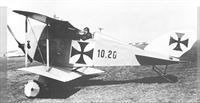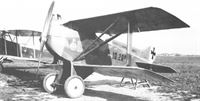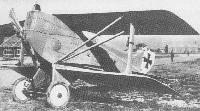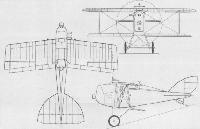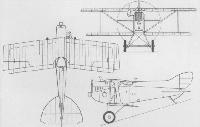
Описание
Страна: Австро-Венгрия
Год: 1916
Fighter
Варианты
- Lohner - 10.20 Spuckerl / Type AA - 1916 - Австро-Венгрия
- Lohner - Dr.I / Type A - 1917 - Австро-Венгрия
- W.Green, G.Swanborough The Complete Book of Fighters
- P.Grosz, G.Haddow, P.Shiemer Austro-Hungarian Army Aircraft of World War One (Flying Machines)
- E.Hauke, W.Schroeder, B.Totschinger Die Flugzeuge der k.u.k. Luftfahrtruppe und Seeflieger 1914-1918
-
E.Hauke, W.Schroeder, B.Totschinger - Die Flugzeuge der k.u.k. Luftfahrtruppe und Seeflieger 1914-1918
Löhner AA 111.03 Prototyp für D I
-
E.Hauke, W.Schroeder, B.Totschinger - Die Flugzeuge der k.u.k. Luftfahrtruppe und Seeflieger 1914-1918
Löhner DD. Flugzeugnummer 10.20 (Erstausführung), ganz aus Holz gebaut
Löhner DD. Самолет № 10.20 (первая версия), полностью деревянный. -
W.Green, G.Swanborough - The Complete Book of Fighters
The original Typ AA featured a very deep, but short, slab-sided fuselage.
-
P.Grosz, G.Haddow, P.Shiemer - Austro-Hungarian Army Aircraft of World War One /Flying Machines/
The Lohner 10.20 (Type AA) prototype (first version), here awaiting radiator installation. The aircraft was designed by Leopold Bauer, who had had no previous experience in singleseat fighter design. The abbreviated fuselage was just 4,70 meters (15.4 ft) long. The prototype was retroactively designated D.I 111.01.
Löhner DD, Flugzeugnummer 10.20 (kurze Ausführung mit I-Stiel)
Löhner DD, самолет № 10.20 (укороченная версия с I-образными стойками) -
P.Grosz, G.Haddow, P.Shiemer - Austro-Hungarian Army Aircraft of World War One /Flying Machines/
Lohner 10.20 prototype (first version - D.I 111.01) with Lohner test pilot Karl Kriger at Aspern in early September 1916. After ground tests demonstrated dangerous characteristics, the prototype was returned to the factory for modification.
-
P.Grosz, G.Haddow, P.Shiemer - Austro-Hungarian Army Aircraft of World War One /Flying Machines/
Lohner 10.20 prototype (second version - D.I 111.01) modified with a lengthened fuselage and new vertical surfaces, with designer Bauer at right. Kriger performed a short maiden flight on 29 December 1916.
-
P.Grosz, G.Haddow, P.Shiemer - Austro-Hungarian Army Aircraft of World War One /Flying Machines/
The Lohner 10.20A prototype (third version - D.I 111.01) was practically a new aircraft. It was given a modified fuselage, a tail fin, an enlarged rudder, and a new wing cellule. Kriger, in the cockpit, performed the first flight on 4 March 1917. The prototype was demolished in a crash on 6 June 1917.
-
P.Grosz, G.Haddow, P.Shiemer - Austro-Hungarian Army Aircraft of World War One /Flying Machines/
The Lohner 10.20B (D.I 111.02) prototype fighter during flight testing at Aspern in the summer of 1917.
-
E.Hauke, W.Schroeder, B.Totschinger - Die Flugzeuge der k.u.k. Luftfahrtruppe und Seeflieger 1914-1918
Lohner-Prototyp, Flugzeugnummer 10.20 B
-
P.Grosz, G.Haddow, P.Shiemer - Austro-Hungarian Army Aircraft of World War One /Flying Machines/
The Lohner 10.20B (D.I 111.02) was the second Type AA prototype built by Lohner. It was first flown on 2 June 1917 by Kriger who reported severe nose-heaviness.
-
W.Green, G.Swanborough - The Complete Book of Fighters
The Lohner 10.20B combined a new fuselage with wings and tail of the 10.20A.
-
P.Grosz, G.Haddow, P.Shiemer - Austro-Hungarian Army Aircraft of World War One /Flying Machines/
Lohner D.I 111.03, the third Type AA prototype, performed its maiden flight on 28 June 1917. Sporadic testing continued through October 1917, when the D.I program was stopped.
The third Typ AA series fighter, the Lohner 111.03 was abandoned in favour of the Aviatik D I. -
W.Green, G.Swanborough - The Complete Book of Fighters
Extensive revision of the Lohner 10.20 resulted in a single 10.20A prototype.
-
W.Green, G.Swanborough - The Complete Book of Fighters
The Lohner 10.20B combined a new fuselage with wings and tail of the 10.20A.
-
P.Grosz, G.Haddow, P.Shiemer - Austro-Hungarian Army Aircraft of World War One /Flying Machines/
Lohner D.I 10.20 (111.01)
-
P.Grosz, G.Haddow, P.Shiemer - Austro-Hungarian Army Aircraft of World War One /Flying Machines/
Lohner D.I 10.20B (111.02)
W.Green, G.Swanborough The Complete Book of Fighters
LOHNER Typ AA (10.20A) Austria-Hungary
During 1916, the Lohnerwerke of Vienna received a contract from the K.u.K.Luftfahrttruppen (Imperial and Royal Air Service of the Austro-Hungarian Army) for four single-seat fighter prototypes powered by the 185 hp Austro-Daimler six-cylinder inline engine. The first of these, the Lohner 10.20, or Typ AA, appeared at Aspern on 5 September 1916. A single-bay biplane with an armament of twin synchronised Schwarzlose machine guns, the Lohner 10.20 was characterised by a singularly abbreviated and deep, slab-sided fuselage. This was suspended between the wings by a short, inverted-Vee cabane and the faired struts supported the undercarriage. The wing cellule had broad, aerofoil-section I-type struts, and the vertical tail possessed no fixed surface. Taxying trials revealed insufficient control. The rudder area was increased several times and the fuselage lengthened before the aircraft flew on 29 December 1916. The fighter demonstrated poor stability, and, after suffering severe damage in February 1917, was returned to the Lohnerwerke for repair and extensive modification. The aircraft re-emerged in the following month as the Lohner 10.20A, the lower wing having been raised to the base of the fuselage, the cabane being eliminated, a twin-strutted wing cellule being adopted, the fuselage being lengthened and the redesigned tail surfaces embodying a fixed fin. The Lohner 10.20A was destroyed in a crash on 6 June 1917, and no data relating to this type are recorded.
LOHNER TYP AA (10.20B) Austria-Hungary
The second fighter prototype from the Lohnerwerke, the 10.20B (later redesignated 111.02), possessed essentially similar wing and tail surfaces to those of the 10.20A. It had a "wireless” wing cabane, however, which reverted to aerofoil-section I-struts supplemented by inclined Vee-struts. It also introduced a deep dorsal fin. Powered by a similar 185 hp Austro-Daimler engine to that of its predecessor and carrying a twin-Schwarzlose gun armament, the Lohner 10.20B made its initial flight at Aspern on 2 June 1917. The prototype was taken over by the K.u.K.Luftfahrttruppen in August 1917, and official trials continued through October when further development was halted. No data relating to this type are available.
LOHNER TYP AA (111.03) Austria-Hungary
The third Typ AA series prototype produced by the Lohnerwerke, the 111.03 differed from its immediate predecessor, the 10.20B alias 111.02, in having a conventional wire-braced wing cellule, a redesigned rudder and unfaired undercarriage strutting. Retaining the 185 hp Austro-Daimler engine, the Lohner 111.03 was flown for the first time on 28 June 1917, and flight testing continued through October. At this stage, the Lohnerwerke was assigned a manufacturing licence for the Aviatik D I, and further development of the Typ AA series was ended.
Max speed, 120 mph (193 km/h).
Time to 3,280 ft (1 000 m), 2.66 min.
Range, 240 mis (386 km).
Empty weight, 1,373 lb (623 kg).
Loaded weight, 2,085 lb (946 kg).
Span, 24 ft 11 1/4 in (7,60 m).
Length, 20 ft 10 in (6,35m).
Height, 9 ft 10 1/8 in (3,00 m).
Wing area, 215.28 sq ft (20,00 m2).
Описание:









